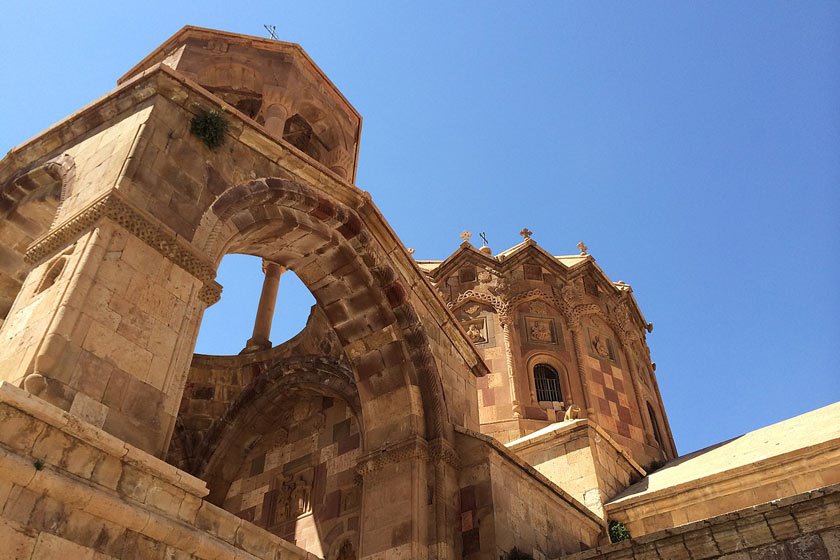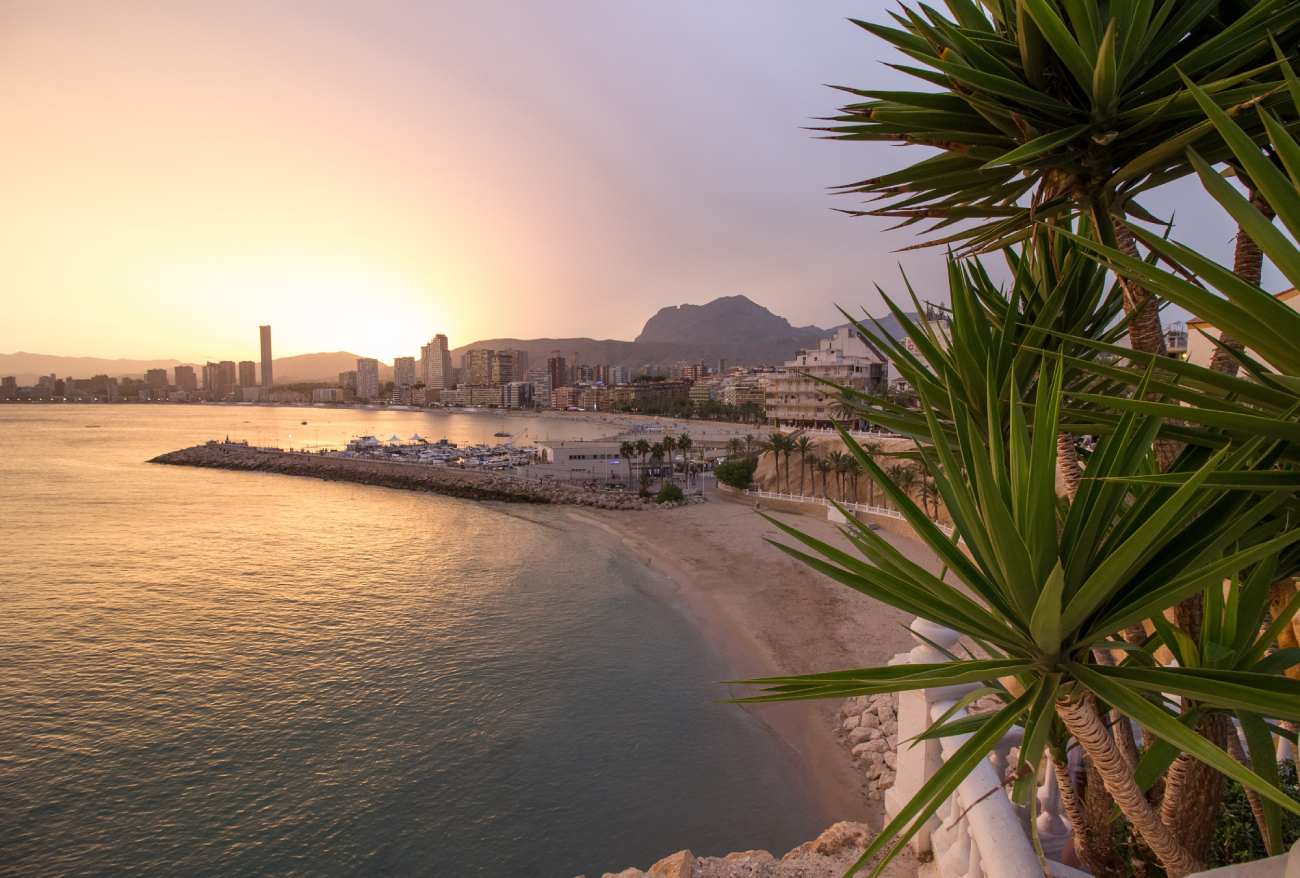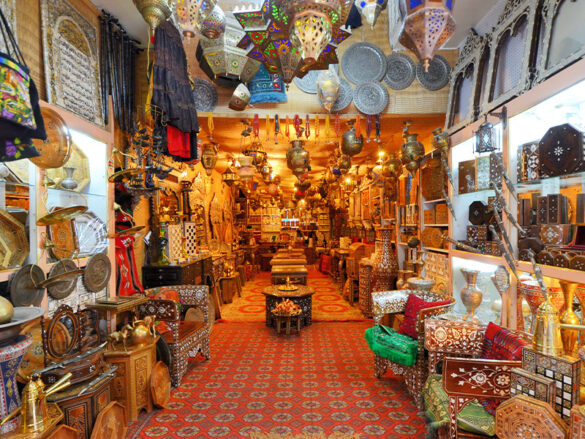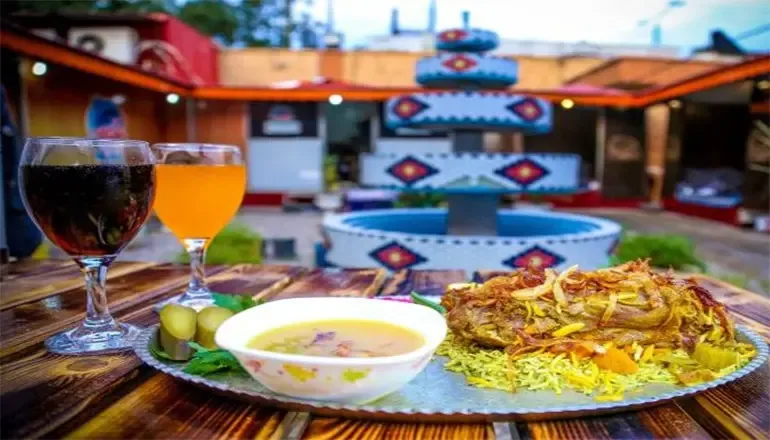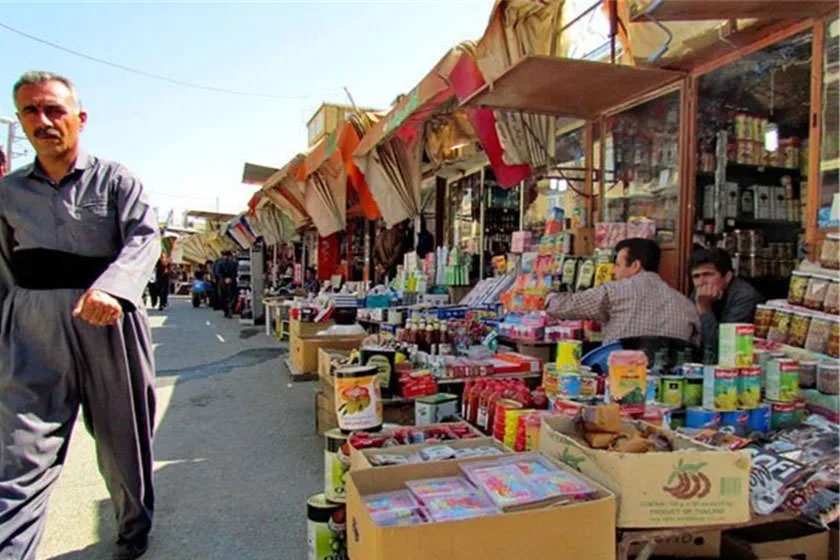St. Stepanos Church: Attractions in Jolfa, Iran
St. Stepanos Church is considered one of the most important churches in Iran, named after one of the Christian missionaries. This church is the second most significant Armenian church in the country after the Qara Kelisa. St. Stepanos Church is located in the Jolfa district of East Azerbaijan province, nestled by the Aras River in the foothills of the Maghard mountains.
Here’s everything you need to know about St. Stepanos Church:
Introduction to St. Stepanos Church:
St. Stepanos Church, located in Jolfa, is one of the most beautiful and significant churches in Iran, situated amidst the pristine nature and bordering the mountains of Jolfa and the Republic of Azerbaijan. It is the second most important Armenian church in Iran after Qara Kelisa, held in high regard by Christians and even followers of other religions. Armenians from various parts of Iran visit this site for pilgrimage annually.
Location of St. Stepanos Church:
St. Stepanos Church is situated in the picturesque region of Jolfa, near the border with the Republic of Azerbaijan, in the free zone of Aras. It is approximately 17 kilometers from the city of Jolfa and is located about three kilometers from the southern bank of the Aras River.
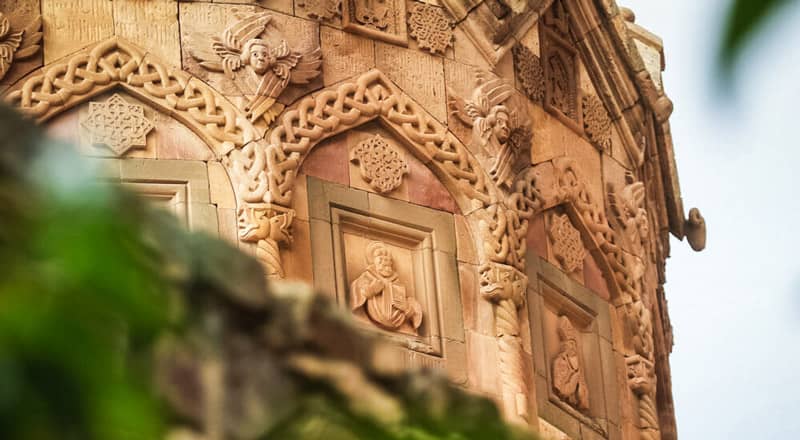
Visiting Hours of St. Stepanos Church:
The church is open for visitors every day from 9 am to 7 pm. Due to its unique geographical location and proximity to the bordering Aras River, during the winter season, you can visit the church until 5 pm.
History of St. Stepanos Church:
St. Stepanos Church has a rich history, being a place of worship for Christians and a center for artists, philosophers, historians, scientists, as well as the education and training of Christian clergy. The church is renowned for its architectural style and cultural significance among Armenians.
Architecture and Plan of St. Stepanos Church:
The architectural style of St. Stepanos Church reflects its cultural and religious importance among Armenians. The church, along with two other churches, Zoor Zoor and Qara Kelisa, was inscribed on the UNESCO World Heritage List in 1386.
Inside St. Stepanos Church:
Apart from being a Christian place of worship, St. Stepanos Church served as a meeting place for artists, philosophers, historians, and scientists. It was also a center for the education and training of Christian clergy.
St. Stepanos Church Museum:
The church houses a museum that preserves numerous manuscripts and artworks created by scribes, calligraphers, painters, and illuminators. Many of these books are now stored in libraries in Armenia and Italy.
In summary, St. Stepanos Church is a significant religious and cultural center for Armenians, with its unique architecture, historical importance, and scenic location making it a must-visit destination in East Azerbaijan province, Iran.

The precise history of St. Stepanos Church
The precise history of St. Stepanos Church is not well-documented. The oldest source mentioning the church dates back to the year 649 AD. Some attribute the construction of the church to the early days of Mesrop Mashtots. Others believe that during the rule of Ashod Bagratuni, King of Armenia, in the year 976 AD (corresponding to 266 Hijri), Catholicos Khachik appointed St. Stepanos as the supervisor of Balqan and, with the king’s funding, built a church in the area.
On the northern bank of the Aras River, there is another church similar to St. Stepanos Church. The proximity of these two churches raises the possibility that they were built simultaneously by a single power governing both sides of the river. Some historical sources, like Tavernier’s travelogue, associate it with the Safavid period, but its architectural style and decorations indicate that the church was constructed between the 4th and 6th centuries Hijri (10th to 12th centuries AD), blending architectural styles from the Urartian, Achaemenid, and Roman periods. After the construction of buildings such as St. Hachmiadzin, Tatavous, Akdamar, and St. Stepanos, this architectural style became recognized as Armenian architecture.
St. Stepanos Church underwent multiple renovations and reconstructions throughout its history. Hakop Joughayetsi, the supreme delegate of St. Stepanos, restored the building between 1053 and 1066 Hijri. During the Safavid era, some reconstructions took place, and in the Qajar period, St. Stepanos remained a focus of attention. According to a stone inscription in Nastaliq script installed above, in 1245 Hijri, Abbas Mirza, the crown prince of the Qajar dynasty, purchased the village of Darreh Sham for 300 tomans and dedicated it to the church.
In contemporary periods, St. Stepanos Church has undergone preservation and restoration, including a notable restoration in 1384 Hijri. During this restoration, skeletal remains were discovered, believed to belong to apostles and Christian saints, including St. Stepanos and Prophet Daniel. Other items, such as bone fragments, pieces of cloth, wax, clay, and poppy seeds, were also identified in the vicinity.
The reason for naming the church St. Stepanos is derived from the Greek word “Stephanos,” meaning a crown and symbolizing perfection in Christianity. St. Stepanos was one of Jesus Christ’s disciples and the first martyred Christian. He was stoned to death by the Jews in Jerusalem on December 26, 36 AD, making him one of the first martyrs of Christianity. Due to its location in a deserted village called Darreh Sham, the church is also known by this name. Additionally, it is referred to as “Dirmaghart” in Armenian sources due to its construction in the Maghard or Dirmaghart mountains.
Architecture of St. Stephen’s Church
To reach St. Stepanos Church, you must pass through a picturesque route with scenic views. Upon arriving at the church, one of the first things that may catch your eye is the beautifully crafted stone dome of the cylindrical structure. The church is situated within a stone wall and a fortress-like enclosure called “Vank” in Armenian, featuring towers, seven guard towers, and five cylindrical and stone backs.
The entrance gate, made of carved wood and iron, is located in the western wall of the Vank. Finely carved stone is used in the foundations of the gate’s sides and the barrel vault, displaying prominent images of Virgin Mary and the Infant Jesus on the lintel of the vault.
On the external walls of St. Stepanos Church, numerous prominent reliefs can be observed, including the Stoning of St. Stepanos on the eastern side, the Crucifixion of Jesus on the western side, and the Ascension of Jesus. Various decorative elements adorn different parts of the church, and the stone façade is adorned with intricate carvings and reliefs. The main prayer hall is decorated with beautiful gypsum paintings.
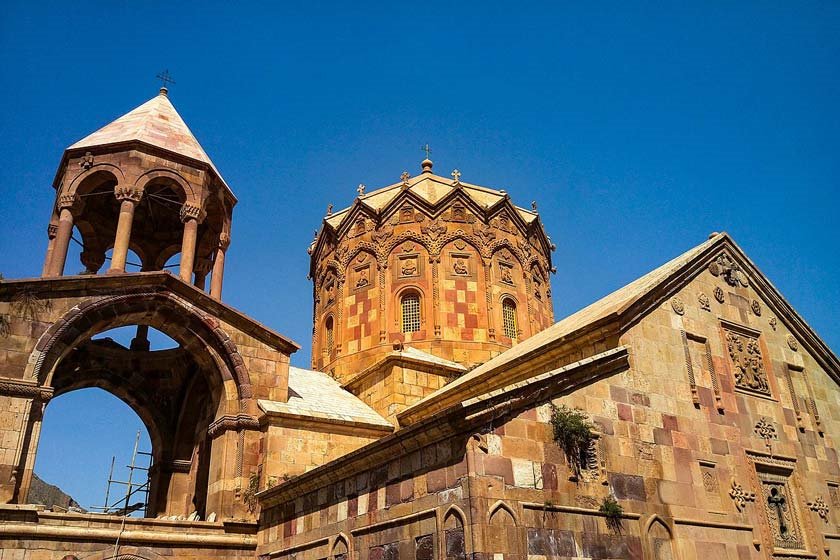
Different Sections of St. Stepanos Church
St. Stepanos Church comprises various sections, including the main prayer hall, the bell tower, Daniel’s Oven or Boaous Petros Chapel, the churchyard or courtyard, the main entrance gate, the eight entrances, the courtyard of the Deirhaha, the old church, the halls for teaching seminarians or the manuscript copying, the residence for monks, and the storage for provisions and collection boxes.
In the following, we’ll introduce three main sections of the church: the bell tower, the main prayer hall, and Daniel’s Oven.
Bell Tower:
The bell tower is one of the most striking parts of the church, featuring a pyramid-shaped dome on an Ivan connected to the southern wall. It has an octagonal shape with a beautiful arrangement of red stone columns and ornate capitals.
Main Prayer Hall:
The main prayer hall of St. Stepanos Church has dimensions of 16 by 21 meters. The entrance door, intricately carved in wood, dates back to the Qajar era. Various decorative elements, including stone carvings on the pillars, vaults, keystones, and chains alongside the molding, adorn the prayer hall. Gypsum paintings embellish the interior, depicting scenes like the crucifixion of Christ.
Daniel’s Oven or Boaous Petros Chapel:
Daniel’s Oven is a part of the internal space of the church, connected to the northern wall. It serves as a hall with dimensions of 6 meters in width and nearly 20 meters in length. This section is separated from the main hall by a wall and is dedicated to St. Daniel, a renowned saint from the 5th century. Daniel’s Oven consists of a meeting hall and a baptismal font at the eastern end. It is named after St. Daniel and features tall pedestals and a stone baptismal font.
The church’s architecture and sections showcase a blend of artistic craftsmanship, religious symbolism, and historical significance, making St. Stepanos Church a remarkable cultural heritage site.
Inside the St. Stepanos Church
The interior space of the church is cross-shaped and consists of three main parts: the vestibule, the prayer hall, and the sanctuary. Behind the vestibule and under the main dome is the prayer hall. The corners of the capitals and the dome’s vault are adorned with colorful images reminiscent of religious paintings from the 16th and 17th centuries. Among the interior decorations are three stone prayer platforms, one in the center of the sanctuary and two on the northern and southern sides of the prayer hall, dating back to the Qajar period.
St. Stepanos Church Monastery
Within the compound of St. Stepanos Church, there is a monastery adjacent to it. The upper floor of this monastery contains rooms for the rest of travelers and pilgrims, while the lower floor used to be stables for quadrupeds. The church’s library was also located in this area.
The architectural style and materials used in the construction of the monastery differ from those of the church. Numerous inscribed stones in Armenian language are installed inside and outside the monastery, providing valuable information about the church’s founder, the architect, and the building’s history.
St. Stepanos Church Museum
A part of the history of St. Stepanos Church is narrated in its museum. The museum consists of two main and side sections. In the main section, a collection of artifacts obtained from the church’s precinct, such as inscriptions and images of historical documents related to the church, is displayed.
In the side section of the museum, historical Armenian churches in Iran are exhibited through stone models and images for the visitors to explore.
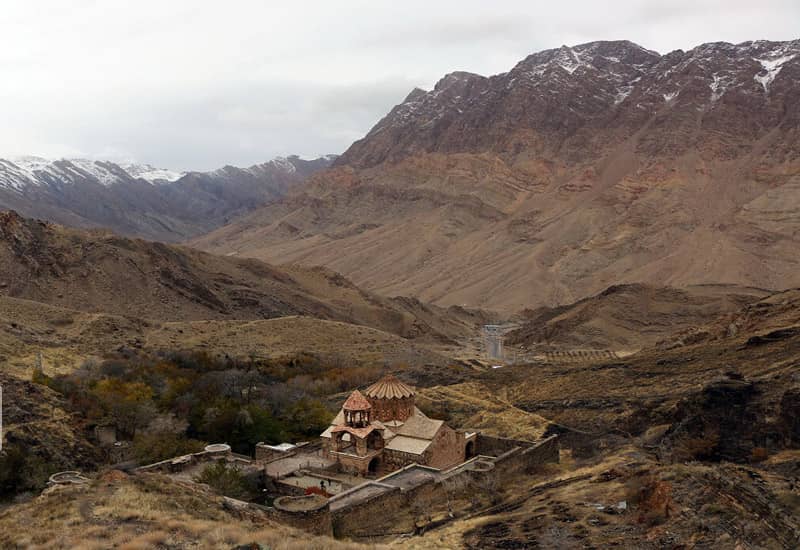
Frequently Asked Questions:
Where is St. Stepanos Church located?
St. Stepanos Church is located near the border of the Republic of Azerbaijan, in the Aras Free Zone, approximately three kilometers from the southern bank of the Aras River.
What are the working hours of St. Stepanos Church?
St. Stepanos Church is open for visitors every day from 9 am to 7 pm. Additionally, during the winter season, you can visit the church until 5 pm, considering its specific geographical location and the border river conditions.
What is the history of St. Stepanos Church?
The exact history of St. Stepanos Church is not accurately known. Some consider it to date back to the early Christian era.
What are the different sections of St. Stepanos Church?
St. Stepanos Church comprises various sections, including the prayer hall, bell tower, and Daniel’s Oven or Boaous Petros Chapel, each contributing to the overall significance of the Jolfa complex.

